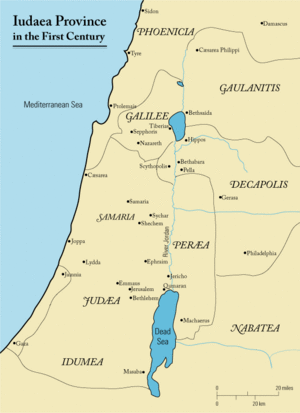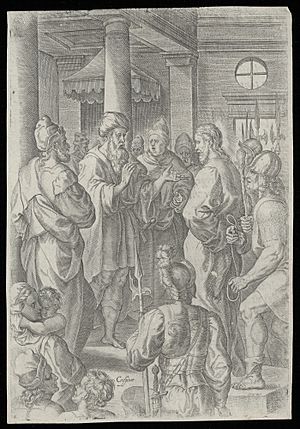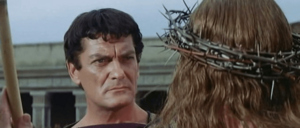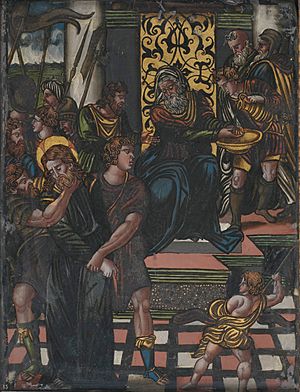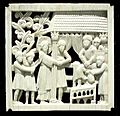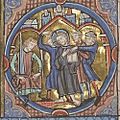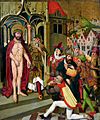Pontius Pilate facts for kids
Quick facts for kids
Pontius Pilate
|
|
|---|---|
| Pontius Pilatus | |
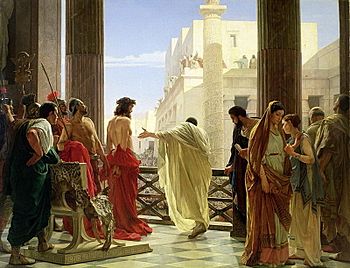
Ecce Homo ("Behold the Man"), Antonio Ciseri's depiction of Pilate presenting a scourged Jesus to the people of Jerusalem
|
|
| 5th Prefect of Judaea | |
| In office c. 26 AD – 36 AD |
|
| Appointed by | Tiberius |
| Preceded by | Valerius Gratus |
| Succeeded by | Marcellus |
| Personal details | |
| Nationality | Roman |
| Spouse | Unknown |
| Known for | Pilate's court |
Pontius Pilate was a Roman governor who lived a long time ago. He was the fifth governor of a Roman area called Judaea. He served under Emperor Tiberius from about 26 AD to 36 AD.
Pilate is most famous for being the official who was in charge of the trial of Jesus. He was the one who eventually ordered Jesus to be crucified.
Contents
Who Was Pontius Pilate?
Pilate's Background
We don't know much about Pilate's early life. We don't know his first name. His last name, Pilatus, might mean "skilled with a javelin." A javelin was a type of spear used in ancient Rome. It could also mean that one of his ancestors was a freed slave.
Pilate was probably well-educated and came from a wealthy family. He was likely married, but there is only one mention of his wife. She warned him about Jesus after having a bad dream. This story is often seen as a legend. Before becoming governor, Pilate likely served in the Roman military.
Pilate's Role as Governor
Pilate was the fifth governor of the Roman province of Judaea. This was during the time of Emperor Tiberius. Being governor of Judaea was not a very important job in the Roman Empire. We don't know how Pilate got this position.
He was governor for about 10 years, from 26 AD to 36 or 37 AD. This made him one of the longest-serving governors of Judaea. As governor, Pilate had the power to choose the Jewish High Priest. He also controlled the special clothes of the High Priest.
Unlike the governor before him, Pilate kept the same High Priest, Joseph ben Caiaphas, for his entire time in office. This shows that Caiaphas and the priests of the Sadducee group were good allies for Pilate.
Pilate and Jesus's Trial
Around 30 or 33 AD, Pontius Pilate sentenced Jesus of Nazareth to death. Jesus was crucified in Jerusalem. The main stories about this event come from the four Christian Gospels. These stories have some differences.
A Roman historian named Tacitus also wrote about Pilate's role in Jesus's death. It is believed that Jesus was brought to Pilate because he claimed to be the "king of the Jews." This was seen as a challenge to Roman rule.
Pilate likely judged Jesus using a special type of trial. This trial was for serious crimes in Roman provinces. It gave the governor more freedom in how to handle the case. The Gospels also say that Pilate had a custom. He would release one prisoner during the Passover festival. This custom is not mentioned in any other historical records.
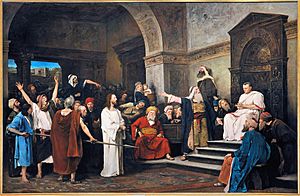
In the Gospels, Pilate seems unwilling to execute Jesus. He is shown being pressured by the crowd and Jewish leaders. Some historians think Pilate hesitated because he feared a rebellion. Many people were in Jerusalem for Passover, and a revolt could have been dangerous.
Pilate's Removal from Office
Pilate was removed from his job after a conflict with a group of Samaritans. These Samaritans were at a village near Mount Gerizim. They were looking for old artifacts. Pilate's soldiers killed many of them. The Samaritans complained to the governor of Syria.
This governor ordered Pilate to return to Rome to be judged by Emperor Tiberius. However, Tiberius died before Pilate arrived. This means Pilate's time as governor ended around 36 or 37 AD.
The new emperor, Caligula, would have handled Pilate's case. It's not clear if a trial actually happened. New emperors often dropped old legal cases. Pilate was not made governor of Judaea again. This could be because the hearing went badly, or he simply didn't want to return. Some think it was just time for him to have a new job after 10 years. Others believe he ended his career in disgrace.
An early historian named Eusebius wrote that Pilate took his own life. This was supposedly due to the shame he felt after being recalled to Rome.
Pilate in Culture and Art
Pilate has been a very important figure in art and stories. This is because of his role in Jesus's trial.
Pilate in Art and Plays
Medieval art often showed scenes of Pilate and Jesus. One common scene shows Pilate washing his hands. This symbolizes him saying he is not guilty of Jesus's death. In later art, Pilate was sometimes shown as a Jewish person. In the 1800s, there was a new interest in painting Pilate.
He also plays a big part in medieval passion plays. These plays tell the story of Jesus's last days. In these plays, Pilate's character changes a lot. Sometimes he is weak and forced to crucify Jesus. Other times, he is shown as an evil person who demands Jesus's death.
Many modern writers have also featured Pilate in their books. These include Anatole France and Mikhail Bulgakov.
Pilate in Movies
Pilate has appeared in many films, even some of the earliest ones about Jesus.
In the 1927 silent film The King of Kings, Pilate is shown under a huge Roman eagle. This eagle represents the great power that controls him. When he sentences Jesus, the eagle is shown next to him. This makes the audience wonder if he served the emperor well.
After World War II, Pilate and the Romans were often shown as villains in American movies. In the 1953 film The Robe, Pilate is covered in gold and rings. This shows the luxury and excess of the Roman Empire. The 1959 film Ben-Hur shows Pilate watching a chariot race. He looks bored and sneering.
Only one film has been made entirely from Pilate's point of view. This was the 1962 French-Italian movie Ponzio Pilato. In the 1973 film Jesus Christ Superstar, Jesus's trial happens in old Roman ruins. This suggests that Roman power is falling apart.
In Mel Gibson's 2004 film The Passion of the Christ, Pilate is shown as a kind character. He is afraid that the Jewish priest Caiaphas will start a riot if he doesn't agree to his demands. He seems upset by how the Jewish authorities treat Jesus.
Interesting Facts About Pontius Pilate
- Some Christian churches, like the Ethiopian Church, consider Pilate a saint. They celebrate him on June 19.
- Pilate washing his hands in the Bible (Matthew 27:24) is a famous image. It's where the English phrase "to wash one's hands of (the matter)" comes from. This means to refuse to be involved or responsible for something anymore.
- Some of Pilate's words in the Gospel of John have become very famous sayings.
- Some people believe that the way the Gospels shift blame from Pilate to the Jewish people for Jesus's crucifixion led to antisemitism (hatred of Jewish people) over many centuries.
- In 2018, a special ring was found at a place called Herodium. It had an inscription that said "of Pilate." The name Pilatus is rare. So, this ring might have belonged to Pontius Pilate or someone who worked for him.
Pontius Pilate Quotes
- numquid ego Iudaeus sum? ("Am I a Jew?")
- Quid est veritas? ("What is truth?")
- Ecce homo ("Behold the man!")
- Ecce rex vester]], ("Behold your king!")
- Quod scripsi, scripsi ("What I have written, I have written").
Images for kids
-
Bronze prutah minted by Pontius Pilate in Jerusalem.Reverse: Greek letters ΤΙΒΕΡΙΟΥ ΚΑΙΣΑΡΟΣ and date LIϚ (year 16 = 29/30), surrounding simpulum.Obverse: Greek letters ΙΟΥΛΙΑ ΚΑΙΣΑΡΟΣ, three bound heads of barley, the outer two heads drooping.
-
Mosaic of Christ before Pilate, Basilica of Sant'Apollinare Nuovo in Ravenna, early sixth century. Pilate washes his hands in a bowl held by a figure on the right.
-
Panel from the Magdeburg Ivories depicting Pilate at the Flagellation of Christ, German, tenth century
-
Ecce Homo from the Legnica Polyptych by Nikolaus Obilman, Silesia, 1466 CE. Pilate stands beside Christ in a Jewish hat and golden robes.
See also
 In Spanish: Poncio Pilato para niños
In Spanish: Poncio Pilato para niños
- List of biblical figures identified in extra-biblical sources


